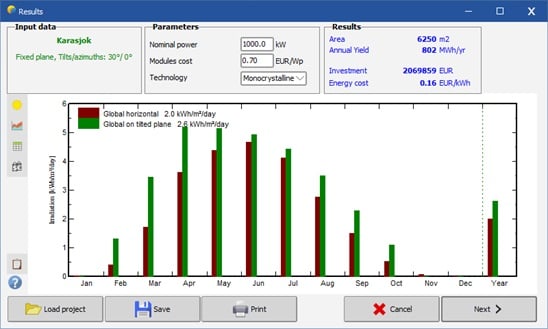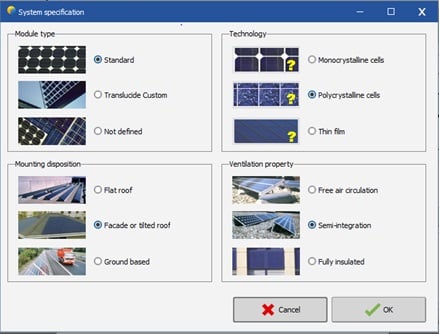PVSyst Review: Pros and Cons of PV system design software package
- There are several software applications used by engineers, project owners, financiers, and architects for designing and modelling solar PV systems. PVSyst is often considered one of the most preferred and used tools in this space. For more than two decades it has enabled users to, size-simulate-and-study PV systems, perform in depth design and analysis, and generate detailed reports.

PVSyst is very useful for technical design, sizing, data analysis, risk mitigation, potential losses, and return-on-investment aspects of a solar PV power system.
Some of the many pros, and few cons of this software application are as follows:
Pros of PVSyst:
- There are three main types of PV systems that can be designed and simulated in PVSyst.
Grid-connected, as the name suggests these systems are connected to the local power grid. For such systems a user can calculate array and system losses, system’s production, performance ratio and normalized production numbers.
Stand alone, such PV systems have the ability to store energy in batteries, or other types of storage devices. Most of the time these systems have some sort of batteries as storage devices. An accurate stand also system design requires the user to have the project-site’s detailed energy consumption requirements, and a per hour daily energy profile. High power, medium power, and small stand alone PV systems for homes, which are typically in the range of 50 to 300W, can also be designed on PVSyst.
Pumping Systems are generally for agricultural applications. In many recent solar pumping systems the modules are mounted on single axis trackers, this application also allows to take the tracker into account during the design procedures. An overview of results for such a system includes, the volume water needs and water pumped, missing water, energy at pump in kWh, system’s efficiency, and specific energy.

- Extensive libraries of PV modules and inverters, PVSyst seems to be more responsive than their competitors here. Any new solar PV module or PV inverter can be found listed in their libraries, for cases where a user is unable to find a specific PAN file of a certain PV panel, they can choose to upload a PAN file, or, design an estimated PAN file from the PV module’s technical specifications sheet.
In addition, users have access to several other components’ databases such as generators, pumps, batteries, and even prices.
As an example, for solar PV modules, users can sort and search the PV module database based on, ‘nominal power’, ‘technology’, or, ‘manufacturer’. Thousands of solar module models, and almost all the major manufacturers are listed in this particular database.
- The most prominent feature of PVSyst is the ability to quickly design a PV power system and estimate hourly, monthly and yearly energy production numbers.
The ability to generate a detailed ‘PV project report’ that usually covers all the vital aspects of a PV system including the all-important economic evaluation, is another highlighted benefit. Energy generation data in graphical form, as shown in image below is also generated.
- With PVSyst, a quick and estimated system design is as easy as: 1. Input the ‘available area’ for the PV project, or, the ‘required system power’. 2. Choose a PV inverter and PV module’s model from PVSysts’ library. 3. Finally, PVSyst will output an initial PV system configuration.

- PVSyst also introduced ‘loss tree’, that enables calculations for PV energy generation losses caused by temperature, PV array mismatch losses, cables losses, and several types of PV inverter losses. Predicting and modelling a PV system’s potential losses is essential for PV turnkey solution providers and project owners.
- This application comes preloaded with meteorological data, or ‘Meteo Database’. Users also have the ability to import weather data from other sources such as Solargis and Meteonorm. When designing a detailed PV system, ‘geographic site parameters’ is usually the first information PVSyst requires. This is due to the fact that the performance and energy output of two identical PV systems would vary based on different geographic locations, so having access to different meteo-databases is essential.
- Extensive support is another highlight of this mighty tool, via their website users have access to video and PDF tutorials, there are several forums too for discussions, and PVSyst also offers dedicated training.
- Because of its long history and features, PVSyst is used by almost every organization working in the solar PV solutions sector. Recently, some companies have chosen to use other softwares too in parallel with PVSyst, in order to do a comparison-analysis of results generated by both tools.

Cons of PVSyst:
There aren’t many limitations of PVSyst, because the Swiss developers are constantly improving and updating this software package. For example, some years ago it was not possible to do shading-analysis with it, but now users can create and manipulate 3D objects, and import from other tools such as AutoCad and Sketchup.
Designing of bifacial PV modules mounted on single-axis trackers is also a challenge being faced by designers these days, PVSyst is working to include more detailed analysis of such systems.
Other notable and widely used PV system design and analysis applications include Helioscope, Aurora, BlueSol, Homer and PVSol.
Also read
